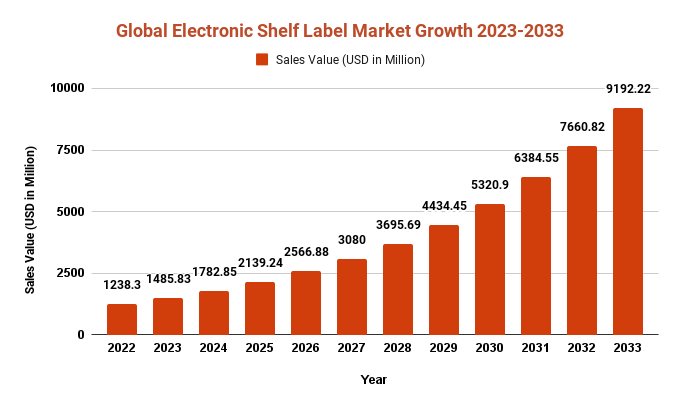Electronic Shelf Label Market To Register USD 9192.22 Mn Revenue By 2033

Page Contents
Market Overview
Published Via 11Press: Electronic Shelf Labels (ESLs) are digital price tags used to display product data and pricing in retail stores. Often, ESLs employ e-paper technology which produces clear images and text with minimal power consumption. Electronic Shelf Labels Market connect directly to a store's inventory and pricing systems, providing accurate product info in real-time. This enables retailers to adjust prices automatically in response to changes in market conditions, promotions or sales quickly.
ESLs can offer retailers many advantages, such as increased efficiency, decreased costs and enhanced customer experience.
The Electronic Shelf Label Market size is expected to reach USD 9192.22 Mn by 2033, up from its current value of USD 1238.3 Mn in 2022, growing at an annual compound growth rate (CAGR) of 19.99% from 2023-2033.
By automating the price tagging process, retailers save both time and money on labor-intensive manual pricing and tagging tasks. ESLs can also minimize pricing mistakes and enhance inventory management, helping retailers prevent overstocking or understocking products. Additionally, ESLs can improve customer experiences by providing accurate pricing data, eliminating any confusion or frustration caused by discrepancies between in-store prices and online prices. They may also provide extra product info like nutritional facts or customer reviews which helps shoppers make more informed purchasing decisions.
Key Takeaways
- Electronic Shelf Labels (ESLs) – ESLs are digital price tags used in retail stores to display product details and prices.
- They employ e-paper technology, which enables them to display sharp images and text while drawing very little power.
- ESLs are usually connected to a store's inventory and pricing systems, enabling them to display accurate product data in real-time.
- ESLs can offer retailers numerous advantages, such as increased efficiency, decreased costs and enhanced customer experience.
- Automating the price tagging process allows retailers to save time and money on labor expenses associated with manual pricing and tagging.
- ESLs can reduce pricing errors and enhance inventory management, helping retailers avoid overstocking or understocking products.
- ESLs can improve customer experiences by providing accurate and consistent pricing data, eliminating any chance for confusion or frustration.
- They can also be utilized to offer additional product details, like nutritional facts or customer reviews, which enable customers to make more informed purchasing decisions.
- ESLs can assist retailers in streamlining their operations and offering customers a superior shopping experience.

Click Here To Access Sample Pages Of This Report: https://marketresearch.biz/report/electronic-shelf-label-market/request-sample/
Regional Snapshot
- North America:
North America is a seasoned market for ESLs, with many large retailers having already adopted this technology. The demand for ESLs in this region is primarily driven by increased efficiency, cost savings and enhanced customer experience. The retail industry in North America is highly competitive; ESLs can help retailers stay ahead of the competition. - Europe:
Europe is the leading market for ESLs globally, boasting a high adoption rate across the region. The demand for these services is driven by increased efficiency, labor savings and compliance with regulations such as the EU's General Data Protection Regulation (GDPR). In highly competitive European retail industries like retail sales, ESLs can help retailers improve their operations and stay ahead of rivals. - Asia-Pacific:
The Asia-Pacific region is rapidly becoming a hub for Electronic Shelf Labels (ESLs), as more retailers adopt this technology to boost efficiency, cost savings and customer experience. As retail industry in Asia-Pacific undergoes rapid evolution, ESLs offer retailers an opportunity to modernize their operations and stay ahead of global competitors. - Latin America:
The Latin American market for ESLs is relatively small but growing. This region's demand is driven by a need for increased efficiency, cost savings, and enhanced customer experience. As retail industry in Latin America evolves, ESLs can help retailers enhance their operations and better serve their customers.
Enquire Here & Query for report: https://marketresearch.biz/report/electronic-shelf-label-market/#inquiry
Drivers
- Increasing demand for automation and digitization in the retail industry: Retailers are increasingly adopting automation and digitization to improve their operations and stay competitive. ESLs provide retailers with an automated solution for pricing and inventory management, reducing the need for manual labor and improving efficiency. Need for accurate and up-to-date pricing: ESLs are connected to a store's inventory and pricing systems, allowing them to display accurate and up-to-date product information in real-time. This helps retailers avoid pricing errors and provides customers with consistent pricing information across all channels.
- With the growing popularity of e-commerce, retailers need to provide a seamless shopping experience across all channels. ESLs can help retailers provide customers with accurate and consistent pricing information, reducing the likelihood of confusion or frustration caused by discrepancies between in-store prices and online prices. ESLs use e-paper technology, which consumes very little power compared to traditional electronic displays. This makes them an energy-efficient solution for retailers looking to reduce their carbon footprint and operating costs. Need for better inventory management: ESLs can help retailers improve their inventory management by providing real-time information on stock levels and pricing. This allows retailers to avoid overstocking or understocking products, improving their bottom line.
Restraints
- Implementing ESLs can be expensive, as it requires investment in new hardware and software systems. This may be a deterrent for some retailers, particularly small businesses or those on tight budgets. Furthermore, some may already have outdated systems which are incompatible with ESL technology; upgrading these can be an extensive and time-consuming process. Furthermore, since ESLs are connected to stores' inventory management and pricing systems, security concerns arise; retailers must guarantee their systems are secure and compliant with regulations such as the General Data Protection Regulation (GDPR) in Europe.
- ESLs can provide accurate pricing information, but they may lack some of the functionality of other digital displays. For instance, they cannot show video content or interactive features which could enhance customer experiences. While ESLs have become popular in some regions such as Europe, their adoption remains relatively low elsewhere such as Latin America or Africa – potentially restricting growth potential of this market there.
Opportunities
- The growing adoption of IoT technology in retail is providing ESLs with new opportunities. IoT-enabled ESLs can be connected to other smart devices and systems, providing retailers with insight into customer behavior, inventory levels, and more. The COVID-19 pandemic has further cemented the trend towards contactless shopping, as customers strive to reduce physical contact with products and other people. ESLs can assist retailers in providing customers with accurate pricing information without the need to touch physical price tags. ESLs can be integrated with mobile apps to give customers additional product details such as reviews, nutritional facts or comparisons – ultimately improving the customer experience and encouraging more purchases.
- ESLs have seen success in some regions, yet there remain untapped markets where the technology could be adopted. Retailers could expand into these emerging areas and offer ESLs as a way to differentiate themselves from competitors. ESLs could display personalized pricing and product recommendations based on customer data like past purchases or browsing history – improving customer experience and encouraging more purchases. The ESL market is expected to keep growing as retailers strive to digitize and automate their processes. With technology advances and evolving customer demands coming together, this presents both vendors of ESL services and retailers alike. It's an exciting time for ESL vendors and retailers alike
Challenges
- One of the major obstacles when implementing ESLs is integrating them with existing systems like inventory management, pricing and point-of-sale. This requires a significant amount of time and effort, as well as possible upgrades. While ESLs use less energy than traditional electronic displays, regular maintenance and battery replacements remain necessary – which could prove costly for retailers with large numbers of ESLs. ESLs utilize e-paper technology which consumes very little power; however their battery life may still be limited in low temperatures or high humidity environments.
- Although ESLs provide retailers with numerous advantages, they face competition from other digital signage solutions such as LCD displays that can show video content and interactive elements. To remain competitive, ESL vendors must continue to develop new capabilities and services. Due to the absence of a standard protocol for Electronic Service Labels (ESLs), retailers may find it challenging to select and incorporate different vendors' products. This could limit market growth potential and cause confusion among buyers. Though ESLs provide retailers with many advantages, there are still challenges that must be addressed. ESL vendors must strive to improve integration with existing systems, reduce maintenance expenses and extend battery life for optimal performance in a crowded market. Furthermore, they need to continue innovating and offering new features in order to remain competitive in this crowded space.
Market Segmentation
Electronic Shelf Label Market, by Component
1. Hardware
Labels (Product) Type
- LCD ESL
- Segmented E-paper ESL
- Full-graphic E-paper ESL
Infrastructure
- Access Points (Transceivers & Base Stations)
- Handheld Devices
2. Software
Pricing and Shelf Management Software
Other Digital Infrastructure
3. Services
Support and Maintenance
Installation
Training and Consulting
Electronic Shelf Label Market, by Communication Technology
- Radio Frequency (RF)
- Infrared (IR)
- Near-Field Communication (NFC)
- Beacon
Electronic Shelf Label Market, by End-use
- Organized Retail Stores
- Super & Hyper Markets
- Malls
- Drug Store/Pharmacies
- Consumer Electronics (Standalone)
- Other Specialty Stores
- Multi Brand Stores
- Company-owned/Brand Stores
Key Players
- Altierre Corp.
- Displaydata Ltd.
- Pricer AB
- SES-imagotag
- E Ink Holdings, Inc.
- Teraoka Seiko Co.ltd.
Report Scope
| Report Attribute | Details |
| Market size value in 2022 | USD 1238.3 Mn |
| Revenue forecast by 2033 | USD 9192.22 Mn |
| Growth Rate | CAGR Of 19.99% |
| Regions Covered | North America, Europe, Asia Pacific, Latin America, and Middle East & Africa, and Rest of the World |
| Historical Years | 2017-2022 |
| Base Year | 2022 |
| Estimated Year | 2023 |
| Short-Term Projection Year | 2028 |
| Long-Term Projected Year | 2033 |
Growing Demand => Request for Customization
Recent Developments
- Increased Adoption of IoT Technology: ESLs are increasingly being integrated with other smart devices and systems through IoT, enabling retailers to collect and analyze data on customer behavior, inventory levels, and more. This helps them optimize their operations while improving the customer experience.
- Improved battery life: ESL vendors are actively researching new battery technologies and power-saving features to extend the battery life of ESLs. This can reduce maintenance expenses and enhance the technology's overall reliability.
- Customization and Personalization: ESL vendors are working on developing software and algorithms that enable more customization and personalization of pricing and product data. This helps retailers better target their customers and enhance the customer experience.
- Increased Utilization of Cloud-Based Systems: ESL vendors are moving towards cloud-based platforms, which offer greater scalability and adaptability. This enables retailers to more easily manage large numbers of ESLs across multiple locations.
- Integration with Mobile Apps: ESL vendors are developing new software and APIs to facilitate deeper integration with mobile applications. This enables retailers to offer customers additional information about products, such as reviews, nutritional facts, or product comparisons.
Contact us
Contact Person: Mr. Lawrence John
Marketresearch.Biz (Powered By Prudour Pvt. Ltd.)
Tel: +1 (347) 796-4335
Send Email: [email protected]
The team behind market.us, marketresearch.biz, market.biz and more. Our purpose is to keep our customers ahead of the game with regard to the markets. They may fluctuate up or down, but we will help you to stay ahead of the curve in these market fluctuations. Our consistent growth and ability to deliver in-depth analyses and market insight has engaged genuine market players. They have faith in us to offer the data and information they require to make balanced and decisive marketing decisions.


